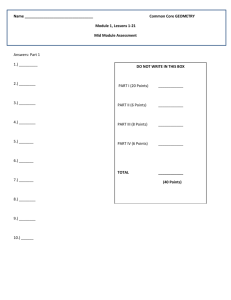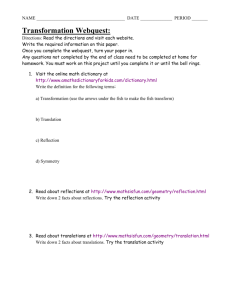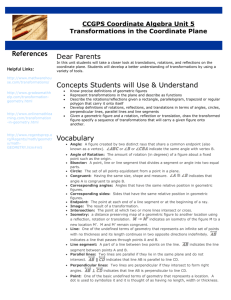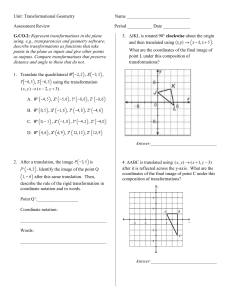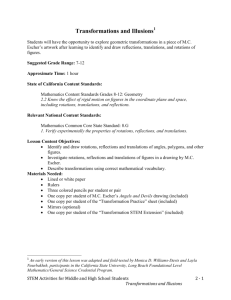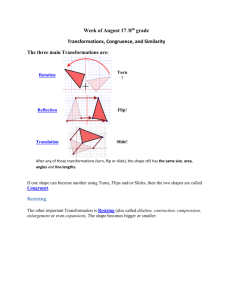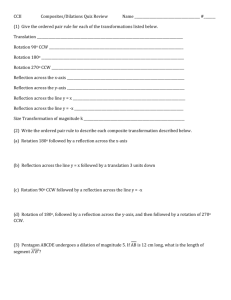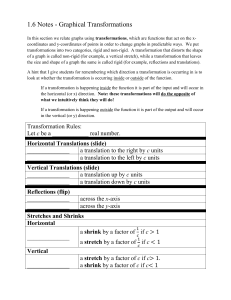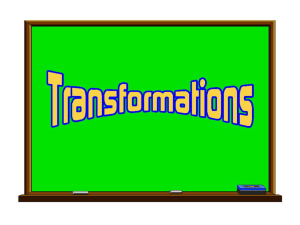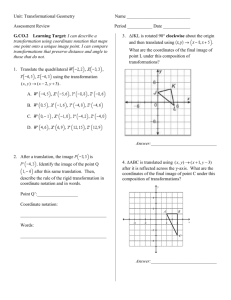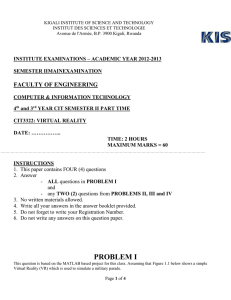notions brainstorm
advertisement
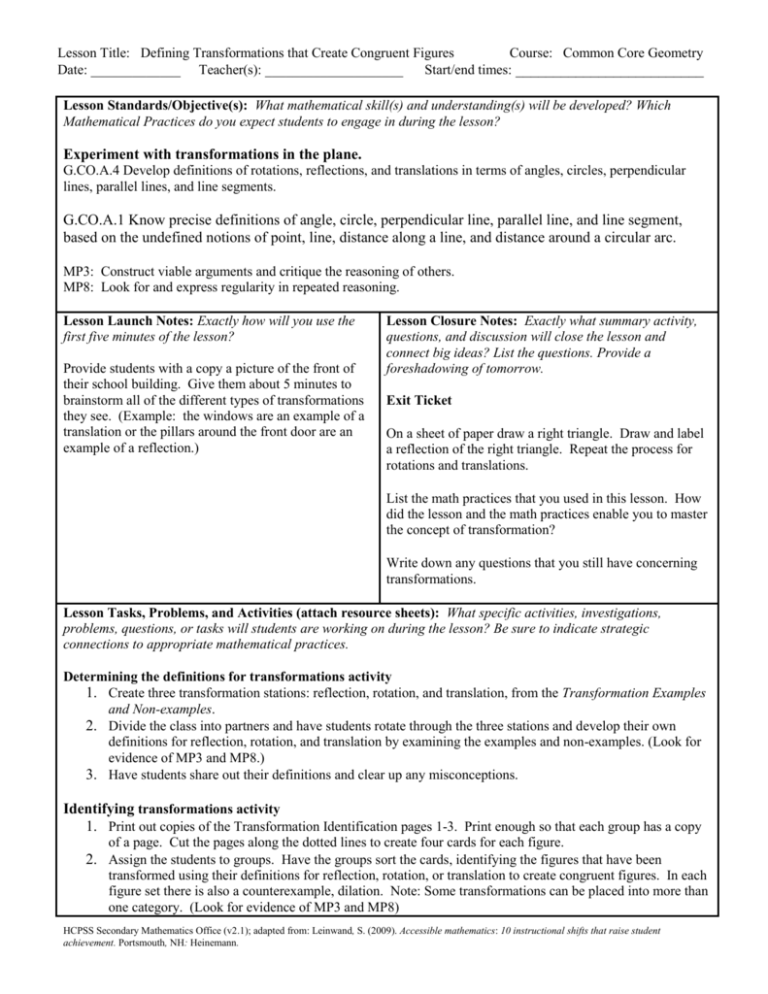
Lesson Title: Defining Transformations that Create Congruent Figures Course: Common Core Geometry Date: _____________ Teacher(s): ____________________ Start/end times: _________________________ Lesson Standards/Objective(s): What mathematical skill(s) and understanding(s) will be developed? Which Mathematical Practices do you expect students to engage in during the lesson? Experiment with transformations in the plane. G.CO.A.4 Develop definitions of rotations, reflections, and translations in terms of angles, circles, perpendicular lines, parallel lines, and line segments. G.CO.A.1 Know precise definitions of angle, circle, perpendicular line, parallel line, and line segment, based on the undefined notions of point, line, distance along a line, and distance around a circular arc. MP3: Construct viable arguments and critique the reasoning of others. MP8: Look for and express regularity in repeated reasoning. Lesson Launch Notes: Exactly how will you use the first five minutes of the lesson? Provide students with a copy a picture of the front of their school building. Give them about 5 minutes to brainstorm all of the different types of transformations they see. (Example: the windows are an example of a translation or the pillars around the front door are an example of a reflection.) Lesson Closure Notes: Exactly what summary activity, questions, and discussion will close the lesson and connect big ideas? List the questions. Provide a foreshadowing of tomorrow. Exit Ticket On a sheet of paper draw a right triangle. Draw and label a reflection of the right triangle. Repeat the process for rotations and translations. List the math practices that you used in this lesson. How did the lesson and the math practices enable you to master the concept of transformation? Write down any questions that you still have concerning transformations. Lesson Tasks, Problems, and Activities (attach resource sheets): What specific activities, investigations, problems, questions, or tasks will students are working on during the lesson? Be sure to indicate strategic connections to appropriate mathematical practices. Determining the definitions for transformations activity 1. Create three transformation stations: reflection, rotation, and translation, from the Transformation Examples and Non-examples. 2. Divide the class into partners and have students rotate through the three stations and develop their own definitions for reflection, rotation, and translation by examining the examples and non-examples. (Look for evidence of MP3 and MP8.) 3. Have students share out their definitions and clear up any misconceptions. Identifying transformations activity 1. Print out copies of the Transformation Identification pages 1-3. Print enough so that each group has a copy of a page. Cut the pages along the dotted lines to create four cards for each figure. 2. Assign the students to groups. Have the groups sort the cards, identifying the figures that have been transformed using their definitions for reflection, rotation, or translation to create congruent figures. In each figure set there is also a counterexample, dilation. Note: Some transformations can be placed into more than one category. (Look for evidence of MP3 and MP8) HCPSS Secondary Mathematics Office (v2.1); adapted from: Leinwand, S. (2009). Accessible mathematics: 10 instructional shifts that raise student achievement. Portsmouth, NH: Heinemann. Lesson Title: Defining Transformations that Create Congruent Figures Course: Common Core Geometry Date: _____________ Teacher(s): ____________________ Start/end times: _________________________ 3. Using the identifications developed by each group, have the groups determine if their definitions need revision. Revise definitions and prepare to share the group’s definitions with the class. 4. Have the groups share their revised definitions with the class. As a class determine the best definitions for each transformation. (Look for evidence of MP3) Follow up discussion questions 1. “How does a reflection, rotation, or translation affect the component parts (line segments, parallel lines, perpendicular lines, or angle measures) of a transformed figure?” 2. “Where do you find examples of reflection, rotation, and translation in the real world?” Evidence of Success: What exactly do I expect students to be able to do by the end of the lesson, and how will I measure student success? That is, deliberate consideration of what performances will convince you (and any outside observer) that your students have developed a deepened and conceptual understanding. Students will be able to develop and refine their definitions of reflection, rotation, and translation by examining the examples and non-examples. Notes and Nuances: Vocabulary, connections, anticipated misconceptions (and how they will be addressed), etc. Transformation Reflection Rotation Translation Dilation (the non-example) Transformations are a change in the location and/or size of a figure. Transformations must create a similar figure to the figure that was transformed. Transformations that can only the location of a figure and create congruent figures include reflections, rotations, translations, and glides. A dilation is an example of a transformation that creates a similar figure that is a different size and in a different location. Resources: What materials or resources are essential for students to successfully complete the lesson tasks or activities? Homework: Exactly what follow-up homework tasks, problems, and/or exercises will be assigned upon the completion of the lesson? Picture of the front of the school building Transformation Examples and NonExamples Transformation Identification pgs. 1-3 Graph Paper Provide students with graph paper to create their own examples of a rotation, reflection, and translation using the definitions they developed in class. Lesson Reflections: How do you know that you were effective? What questions, connected to the lesson standards/objectives and evidence of success, will you use to reflect on the effectiveness of this lesson? Are students able to articulate the definitions of the transformations: reflection, rotation, and translation? Are students able to recognize the difference between the examples and non-examples of reflections, rotations, and translations? HCPSS Secondary Mathematics Office (v2.1); adapted from: Leinwand, S. (2009). Accessible mathematics: 10 instructional shifts that raise student achievement. Portsmouth, NH: Heinemann.
